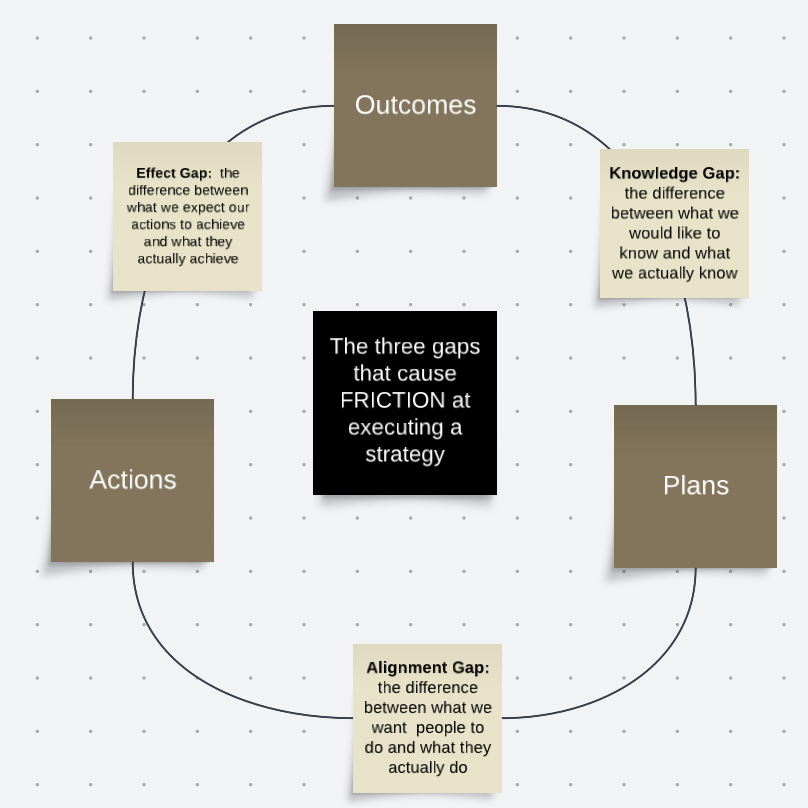The Art of Action
I have come to realize that Stephen Bungay's book, The Art of Action, is possibly one of the most hidden gems in terms of strategy execution out there. I at least only heard of it once or twice before purchasing it, reading and getting blown away by the simplicity and practicality of his insights.
So I decided to go ahead and share some of the key learnings over here. To be clear, my intention it's by no means to summarize the book but rather to share some aspects and implications of what called my attention most.
It's still a lovely story to read fully, particularly because it's quite insightful how Stephen Bungay, a strategic consultant who is also a military historian, put things all together, drawing the very context where strategic deployments are arguably at peak in challenges and complexity, and surely on consequences, to then apply to business.
The 3 gaps and our counterproductive typical reaction
The first, and perhaps the most fundamental, realization is drawn from Karl von Clausewitz (German philosopher of war) idea of friction, which Bungay portrays as the 3 gaps between outcomes, plans, and actions, which impact strategy execution.
Now, whenever we are confronted with signals of friction out of any of those gaps, our natural human reaction typically takes us to assume we need "more" (of…), but counterintuitively that often makes things worse, not better.
I say it's counterintuitive because, for example, how on earth can anyone justify that more detailed information, or instructions, are not helpful!? At least on the surface, it doesn't smell right. But if you think further about it, it's all about understanding the importance of both not adding to the noise and giving teams the latitude they need to figure out the best way to approach the challenges once it's clear the intent, what we are trying to achieve (either in a clear and concise destination and/or sense of direction).
The fractal-like dynamic that make it robust
For quite a while I have observed and realize that a heuristic for something to be robust is to see how easily the same pattern can work at different levels. That's precisely the idea of a fractal-like pattern.
To me, the learnings from Stephen Bungay's Art of Action would easily fit that bill. In fact, often the implication is the expectation of repeating patterns across levels, where the lower you are, the more details that can be (which is a natural expectation).
So, the other day when I presented a short keynote with the insights from the book to my team, I talked about some concrete ways where we could make sure of the patterns implied by the approach in our context:
What if you try to prepare for the quarterly planning using this approach? What could that look like? You would just give enough direction and communicate clearly the intent (i.e., what truly matters) for the upcoming quarter, and then give the latitude to the team to figure out their proposal plan and 'backbrief' what's possible in the given time frame. Also giving the clarity that, for as long as they stick to the intent, they have the leeway to adapt the plans and the actions as we move on within the quarter.
Pills of wisdom in quotes
The other thing I also shared in the hope of providing insight to people was a set of quotes from the book, which at least to me were indeed very inspiring.
“In order to provide guidance for decision making under continually evolving circumstances, strategy can be thought of as an intent”
“Strategy is about fighting the right battles, the important ones you are likely to win. Operations is about winning them. The intelligent way to manipulate luck is to observe the effects of actions and exploit success”
“We manipulate luck by making a series of small choices which open up further options”
“Business engage in a vast range of activities. The art of strategic thinking is to identify which of them is the decisive differentiator, the determinant of competitive advantage. It involves mastering and sorting through a vast range of activities and simplifying them accurately down to the essentials which make the difference. The true strategist is a simplifier of complexity”
“Rather than a plan, a strategy is a framework for decision making. It is an original choice about direction, which enables subsequent choices about actions. It prepares the organization to make those choices. Without a strategy, the actions taken by an organization degenerate into arbitrary sets of activity. A strategy enables people to reflect on the activity and gives them a rationale for deciding what to do next”
Think about that for a moment, knowing that this is stuff from the late 19th century… How much that is aligned with what we believe to be a rather modern challenge for business, with the understanding of complex systems, fast-moving, requiring to continuously adapt to the circumstances that emerge.
It makes me think and feel we need much more, and to quote Isaac Newton, to be "standing on the shoulders of giants", not to assume these days challenges to be any fundamental specificity. Arguably that we just have the luxury, or the opportunity, to shorten feedback loops leveraging information technology and a digital world. We somehow often seem to rather add to the noise, as opposed to staying focused on what matters.
By Rodrigo Sperb, feel free to connect, I'm happy to engage and interact. If I can be of further utility to you or your organization in getting better at working with product development, I am available for part-time advisory, consulting or contract-based engagements.






